2012 Week 6
Despite the record heat this week, a number of good things happened at the site. Field school had a visit from Channel 5 News on Thursday.
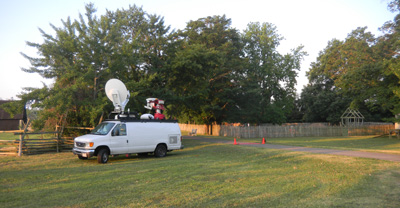
TV news van at the Calvert House site.
They did a number of live remotes from the site throughout the morning news program. I managed to get the HSMC Archaeology banner in the background. It was an exciting way to start the day! In addition to sharing the exciting work we are doing, we got to advertise Tidewater Archaeology Weekend to a much larger audience.
So that everyone had a chance to be seen on TV, the whole crew worked in one area on two quadrants under the smokehouse.
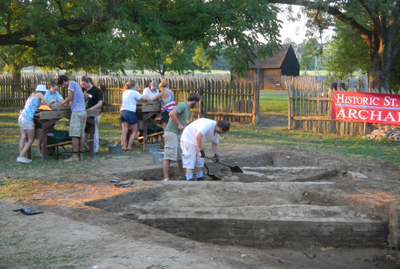
Crew excavating fill from the cellar area.
While this was specifically for the TV, it had a bigger purpose as well. It was in this area that the southern wall of the burned clay cellar had to be located. Before it could be defined, we needed to remove the dark red sandy soil from these units. This stratum was an intentional fill and it was the last soil added to the site before the 1840s outbuildings were constructed. It was seen in the area between the outbuildings and the builder’s trenches for those structures cut into this soil. Almost all the artifacts found in this level date to the 17th century but there are some few 19th-century ones in good context. I suspect that this stratum was specifically deposited in the 1840s to level the area in preparation for construction of the outbuildings.
Since the dark red sandy fill was brought into the house area from somewhere else, we need to think about where it might have come from. The fill contains large amounts of bone (including fish bone), oyster shell, and brick along with artifacts dating throughout the 17th century. This collection of materials looks very familiar as we spent part of the last two summers excavating in the midden just to the west of the house site. The midden contained exactly this mix of materials. There is no way to positively say that this fill came from the midden but it shares many of the characteristics and would have been available very close by.
One of the units excavated in this area produced a remarkable collection of small things.
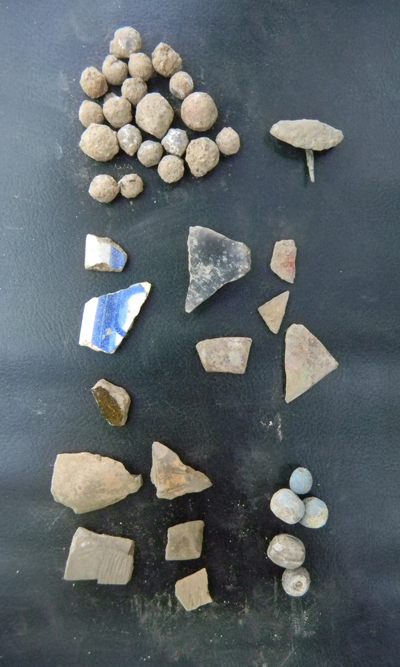
Selection of small things from the unit over the cellar.
In this tiny area, the dark red sandy fill contained 5 glass beads, 20 lead shot, and a large number of small glass fragments, ceramic sherds, and tobacco pipes. The minute, broken nature of the glass, ceramics, and tobacco pipe fragments suggests that this load of fill came from an area of heavy foot traffic. The beads and the lead shot, perhaps lost rather than thrown away, may indicate the same thing. Part of the midden filled in a ravine that was the main access from the house kitchen to the fresh water spring by the river, again suggesting the origin of the fill.
All of this work under the smokehouse finally paid off as we found the southern edge of the cellar.
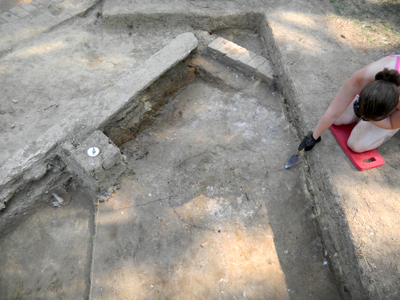
Ann Slater trowels the southern edge of the cellar.
The first indication of the cellar was directly under the hard-packed fill where we found a loose, white, ashy soil with large amounts of charcoal in it. During the 1980s, while excavating pipe trenches outside the smokehouse, excavators noted that the cellar had been only partially filled and the upper portion seemed to have accumulated ash and charcoal from the sweepings of the house’s chimneys. In at least one case, they saw the ashy soil lying on top of the burned clay wall of the cellar. Our excavation found the same situation as the photo shows the ashy soil where it meets unplowed humus with no evidence of the burned clay. The photo also shows a large, round feature cutting into the cellar fill. This will have to be excavated before we can do anything with the cellar and it may reveal the wall.
One of the interesting artifacts found this week was a large piece of prehistoric pottery.
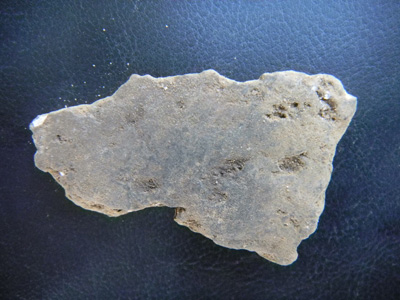
Shell-tempered, prehistoric pottery sherd.
This piece was shell tempered and dates to the Middle or Late Woodland periods (c. 200 B.C.-1634 A.D). Further analysis will narrow this time range. It was about 3 inches long and much larger than the pieces we often find. It was found in the dark red sandy fill above the cellar and again indicates the nature of the fill. The piece also shows the difference between plow zone material and the more protected artifacts found in intentional fills. When we excavate plow zone, the largest prehistoric sherds are about the size of a dime.
Given the effect that the plow has on artifacts, this fragile piece of 17th-century table glass is all the more remarkable.
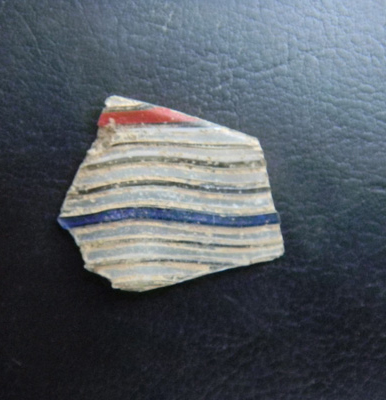
Red, white, and blue beaker fragment.
It was found in a plow zone unit north of the house and was slightly larger than a quarter. As the photo shows, it is a piece of clear glass on which thin lines of red, white and blue glass have been applied (How appropriate for the day after the 4th of July!). Similar pieces of glass have been found at the Calvert House in the past and are reported in Anne Grulich’s 2004 study of 17th-century table glass from HSMC. She reported examples that had red and while lines. In the Town Center area, adjacent to the Calvert House, fragments of similar glass with blue and white lines have been found. This is the first fragment that has all three on one piece. The form of the vessel is a tall, cylindrical beaker and Grulich illustrates a surviving example from the Netherlands. It is truly a beautiful piece of glass.


